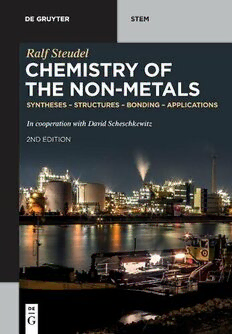
Chemistry of the Non-Metals: Syntheses - Structures - Bonding - Applications (De Gruyter Textbook) (De Gruyter STEM) PDF
Preview Chemistry of the Non-Metals: Syntheses - Structures - Bonding - Applications (De Gruyter Textbook) (De Gruyter STEM)
RalfSteudel ChemistryoftheNon-Metals Also of interest BioinorganicChemistry. Rabinovich, ISBN----,e-ISBN---- InorganicTraceAnalytics. TraceElementAnalysisandSpeciation Matusiewicz,Bulska(Eds.), ISBN----,e-ISBN---- InorganicPigments. Pfaff, ISBN----,e-ISBN---- IndustrialInorganicChemistry. Benvenuto, ISBN----,e-ISBN---- ReviewsinInorganicChemistry. Editor-in-Chief:Schulz,Axel ISSN-,e-ISSN- Ralf Steudel Chemistry of the Non-Metals Syntheses – Structures – Bonding – Applications In cooperation with David Scheschkewitz Authors Prof.Dr.RalfSteudel Grethe-Weiser-Weg11 D-14055Berlin,Germany [email protected] Prof.Dr.DavidScheschkewitz SaarlandUniversity Krupp-ChairofGeneralandInorganicChemistry D-66123Saarbrücken,Germany [email protected] ISBN978-3-11-057805-8 e-ISBN(PDF)978-3-11-057806-5 e-ISBN(EPUB)978-3-11-057831-7 LibraryofCongressControlNumber:2019947567 BibliographicinformationpublishedbytheDeutscheNationalbibliothek TheDeutscheNationalbibliothekliststhispublicationintheDeutscheNationalbibliografie; detailedbibliographicdataareavailableontheInternetathttp://dnb.dnb.de. ©2020WalterdeGruyterGmbH,Berlin/Boston Coverimage:Philiphotographer/E+/gettyimages Typesetting:IntegraSoftwareServicesPvt.Ltd. Printingandbinding:CPIbooksGmbH,Leck www.degruyter.com Preface HowwouldourplanetEarthlooklikewithoutnonmetals?Nowater,noair,nolife! Not evenrocks and sand sinceoxygenand silicon are responsiblefor 72.7%of the mass of crustal rocks on the Earth. The human body consists of 96.6% of oxygen, carbon,hydrogenandnitrogen.Ifalltheothernonmetallicelementsareadded,we endupwith98.0%.Nonmetalcompoundsplayacrucialroleinourdailylifeandin industry as you will see in this book. It is therefore obvious that the chemistry of the nonmetals is a major part of the chemical education at all levels, from high schooltouniversity. Thebookyouareholdinginyourhandsisveryspecialtome.Iwrotethefirst German edition at the very early stage of my academic career, shortly ahead of my one-year sabbatical leave at M.I.T., Cambridge (Massachusetts). It originated frommylecturesattheTechnicalUniversityBerlin,theplaceknownasahotspot of nonmetal chemistry research. With the years, the book became my lifetime project.Iwasfortunateenoughtosharemypassionandinterestinthechemistry of the nonmetals (and the yellow element in particular) with many friends and colleagues in academia and industry all over the world. Thus, the book was al- ways nourished with the modern developments in fundamental and industrial research. Five editions of this monograph have been published by de Gruyter, Berlin/ Boston, each time completely modernized and extended. This newest interna- tionaleditionisanupdatedtranslationofthelatestGermaneditionof2013.Iam grateful tomy twoyounger colleagues whoshare the same passion – Prof. David Scheschkewitz at Saarland University (Germany) who contributed in translating andupdatinghalfofthepresentedition;andProf.IngoKrossingattheUniversity of Freiburg (Germany) whose know-how enriched several chapters of a previous Germanedition. The book presents an infinite variety and marvelous chemical subtlety of the 22elementsoccupyingtheupper-rightsectionofthePeriodicTableandofhydro- gen,whichwasattheoriginoftheuniversewhenitstarted13.8billionyearsago andfromwhichallotherelementswereformedbynuclearreactions.Theworkis organized in two parts: Part I explains the basic theoretical concepts needed to understand the structures and reactions of (nonmetallic) molecules and crystals. ThelargerPartIIpresentsthesyntheses,structuresandapplicationsofthecorre- sponding compounds and materials. We also address their significance in daily life, chemical industry, environment, material science and farming wherever possible. Numerous review articles and original publications are cited in footnotes and encouragethereaderstostudycertaintopicsmoreextensively.Tokeepthesizeof thefootnoteswithnearly1000referencesundercontrol,however,onlyoneauthor is given if there are more than three. In addition, well-established handbooks of https://doi.org/10.1515/9783110578065-202 VI Preface inorganic chemistry (e.g., GMELIN1) and chemical technology (e.g., ULLMANN2 WINNACKER-KÜCHLER3BÜCHEL-MORETTO-WODITSCH4andKIRK-OTHMER5)maybeconsulted asausefulsourceofinformation.Literatureclosingdatewasspring2019. In recommending the book to its readers, I like to acknowledge the advice by Profs.SebastianHasenstab-RiedelandChristianMülleroftheFreeUniversityBerlin and the help by Dr. Anja Wiesner who assisted with the graphics. Furthermore, I ammostgratefultomywifeDr.YanaSteudelformanyyearsofsupportandcooper- ationonthevariouseditionsofthisbook.DeGruyterPublisherinBerlinsupported this project from day 1, so that many people who worked with me all these years shouldbeacknowledged. Many colleagues, coworkers and students contributed to the success of this book with their comments and suggestions and I will be happy to hear from the readersofthiseditiontoo. Berlin-Charlottenburg, June2019 RalfSteudel 1 GmelinHandbookofInorganicandOrganometallicChemistry–8thedition,Springer,bookseries with185volumes(partlyinEnglish),publishedin1936–1995. 2 Ullmann’sEncyclopediaofIndustrialChemistry,Wiley-VCH,Weinheim,2006;manyvolumesand onlineedition. 3 Winnacker-Küchler: Chemische Technik, Vol. 3: Anorganische Grundstoffe, 5th ed., Wiley-VCH, Weinheim,2005. 4 K.H.Büchel,H.-H.Moretto,D.Werner(eds.),IndustrialInorganicChemistry,2nded.,Wiley-VCH, Weinheim,2008. 5 Kirk-Othmer(eds.),EncyclopediaofChemicalTechnology,5thed.,Wiley,NewYork,2004;book serieswith27volumes. Contents Preface V Part I:ChemicalBonds andPropertiesof Molecules 1 Introduction 3 2 TheChemicalBond 11 2.1 TheIonicBond 13 2.1.1 General 13 2.1.2 TheIonizationEnergyE 13 i 2.1.3 TheElectronAffinityE 15 ea 2.1.4 IonicCrystalsandIonicRadii 17 2.1.5 LatticeEnergyandLatticeEnthalpy 19 2.1.6 DeterminationofLatticeEnergiesandEnthalpies 21 2.1.7 SignificanceoftheLatticeEnthalpy 23 2.1.7.1 ComplexFormationofMetalHalides 26 2.1.7.2 WeaklyCoordinatingAnions 27 2.1.8 PolarizationofAnionsbyCations 27 2.2 MolecularGeometry 30 2.2.1 StructureDetermination 30 2.2.2 TheVSEPRModelforEstimationofMolecularGeometries 32 2.2.2.1 LoneElectronPairs 38 2.2.2.2 SingleElectronDomains 40 2.2.2.3 SubstituentsofDifferingElectronegativity 40 2.2.2.4 MultipleBonds 41 2.2.2.5 FinalRemarksontheVSEPRModel 41 2.3 MolecularSymmetryandPointGroupSymbols 43 2.4 TheCovalentBond 48 2.4.1 TheMolecularIon[H ]+ 49 2 2.4.1.1 TheLCAOApproximation 50 2.4.2 TheMoleculeH 57 2 2.4.2.1 TheCation[He ]+ 59 2 2.4.2.2 TheRoleofAntibondingMolecularOrbitals 59 2.4.3 HomonuclearDiatomicMolecules 60 2.4.4 PhotoelectronSpectroscopyofSmallMolecules 68 2.4.5 HeteronuclearDiatomicMolecules 70 2.4.5.1 GeneralRulesfortheConstructionofMOs 72 2.4.6 Three-AtomicMoleculesofD∞hSymmetry 73 2.4.6.1 TheMoleculeBeH 75 2 VIII Contents 2.4.6.2 TheMoleculeCO 76 2 2.4.7 Three-AtomicMoleculesofC Symmetry 77 2v 2.4.8 Four-AtomicMoleculesofD Symmetry 80 3h 2.4.9 Four-AtomicMoleculesofC Symmetry 83 3v 2.4.10 Five-AtomicMolecules 87 2.5 TheCoordinateBond 89 2.6 HypercoordinateMolecules 93 3 VANDERWAALSInteraction 101 3.1 TheDipoleEffect 101 3.2 InducedDipoleEffect 104 3.3 TheDispersionEffect 104 3.4 VANDERWAALSRadii 107 3.5 VANDERWAALSMolecules 109 4 BondProperties 113 4.1 Introduction 113 4.2 BondEnthalpyandDissociationEnthalpy 114 4.2.1 DiatomicMolecules 114 4.2.2 PolyatomicMolecules 117 4.2.3 WhyIsOxygenaGasandSulfuraSolid? 122 4.3 TheInternuclearDistance 124 4.4 TheValenceForceConstant 127 4.4.1 DiatomicMolecules 127 4.4.2 DiatomicGroups 128 4.4.3 Three-AtomicMolecules 129 4.5 RelationshipsBetweenDifferentBondProperties 132 4.6 PolarityofCovalentBondsandElectronegativity 134 4.6.1 Introduction 134 4.6.2 Electronegativities(χ) 136 4.6.2.1 ThermodynamicElectronegativitiesbyPAULING 136 4.6.2.2 ElectronegativitiesaccordingtoALLREDandROCHOW 138 4.6.2.3 SpectroscopicelectronegativitiesaccordingtoALLEN 141 4.6.2.4 GroupElectronegativities 142 4.6.3 TheDipoleMoment 143 4.7 ElectronDensityDistributioninMoleculesandCrystals 147 4.7.1 PromoleculeandDeformationDensity 147 4.7.2 HalogenBonding 149 Contents IX Part II:Chemistry oftheNon-Metals 5 Hydrogen 157 5.1 ElementalHydrogen 157 5.1.1 ProductionandUses 157 5.1.2 IsotopesofHydrogen 161 5.1.3 PropertiesofHydrogen 164 5.2 HydrogenIonsH+ 165 5.3 Acids 168 5.3.1 OxoniumSalts 169 5.3.2 LiquidAmmonia 171 5.3.3 AnhydrousSulfuricAcid 172 5.4 Bases 172 5.5 TheRelativeStrengthofAcidsandBases 174 5.5.1 DiluteSolutions 174 5.5.1.1 BinaryCovalentHydrides 175 5.5.1.2 Oxoacids 176 5.5.2 ConcentratedandNonaqueousAcids 177 5.6 HydrogenBonds(H-Bonds) 181 5.6.1 Introduction 181 5.6.2 GeneralPropertiesofHydrogenBonds 182 5.6.3 ExperimentalDetectionofHydrogenBonds 183 5.6.3.1 PhysicalConstants 183 5.6.3.2 StructureDetermination 185 5.6.3.3 MolecularSpectroscopy 185 5.6.4 ExamplesofSpecialHydrogenBonds 187 5.6.4.1 HydrogenFluoride 187 5.6.4.2 IceandWater 188 5.6.4.3 GasHydratesandClathrateHydrates 194 5.6.4.4 AmmoniaandAmines 195 5.6.5 TheoryofHydrogenBondFormation 198 5.7 HydrogenCompounds(Hydrides) 202 5.7.1 Introduction 202 5.7.2 CovalentHydrides 203 5.7.2.1 ActivationofH Molecules 203 2 5.7.3 H asLigandinCoordinationCompounds 204 2 5.7.4 Salt-LikeHydrides 206 5.7.5 Metal-andAlloy-LikeHydrides(InsertionHydrides) 209 5.7.5.1 BondingofHydrogeninAlloy-LikeHydrides 211
